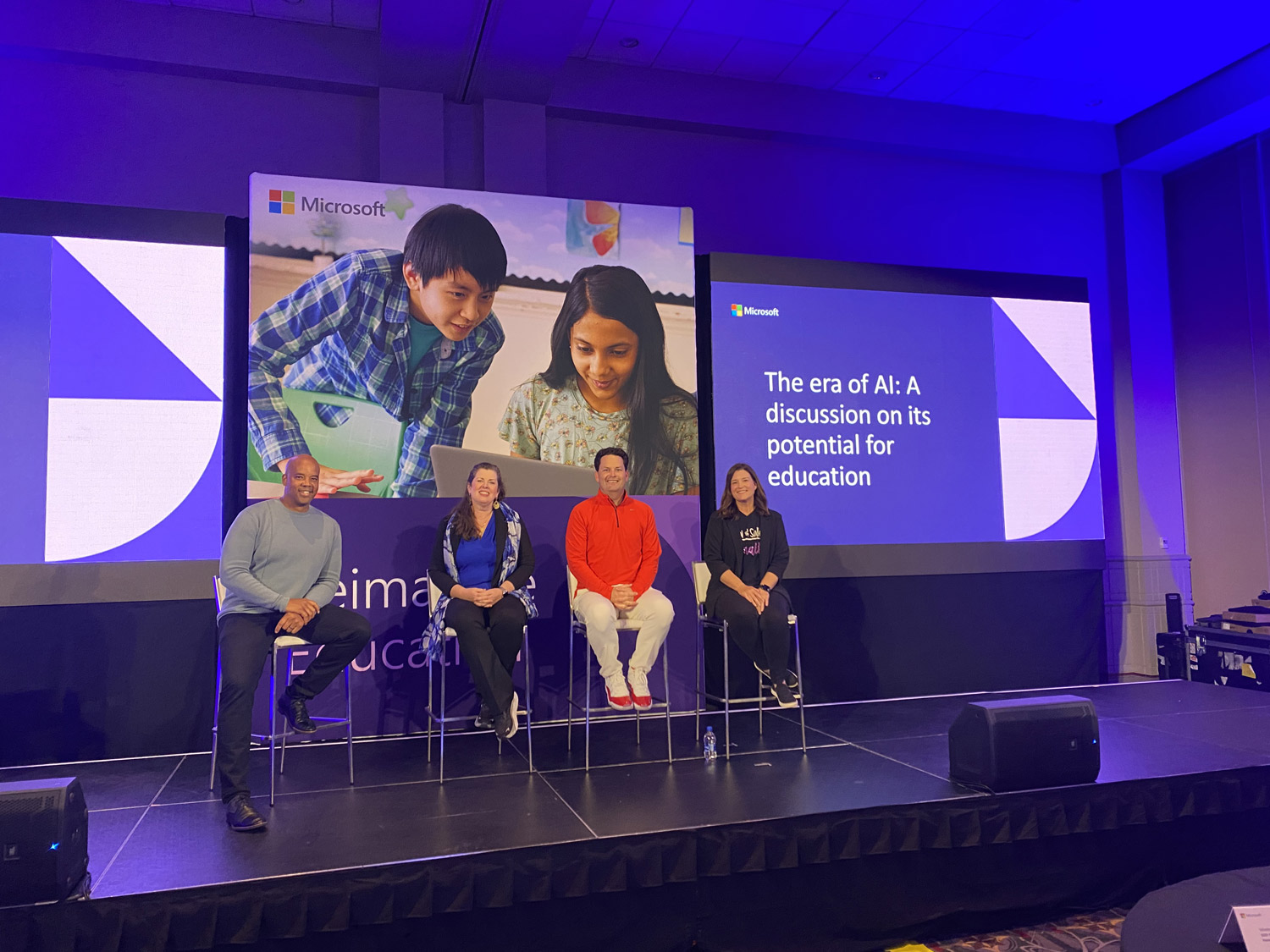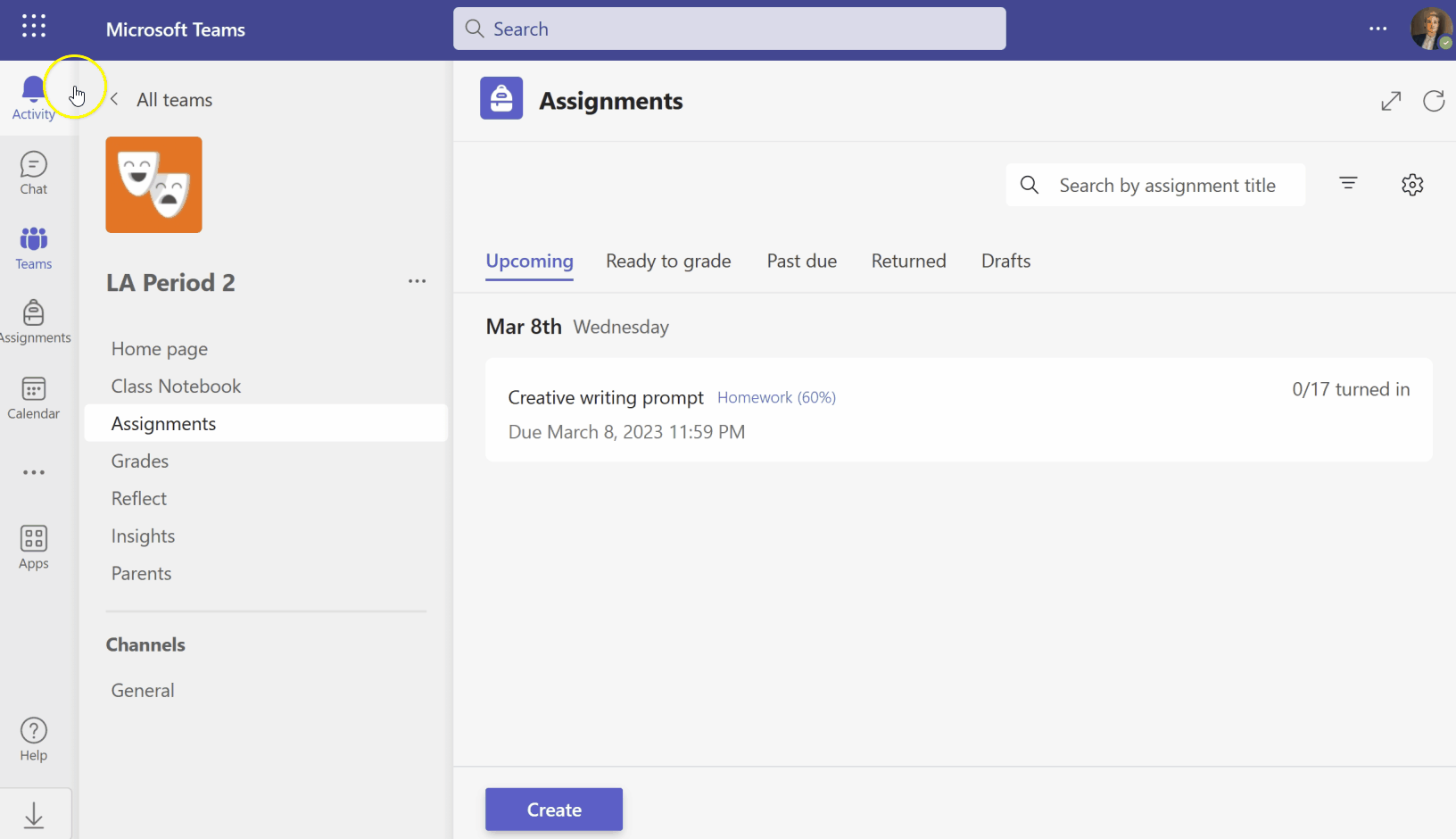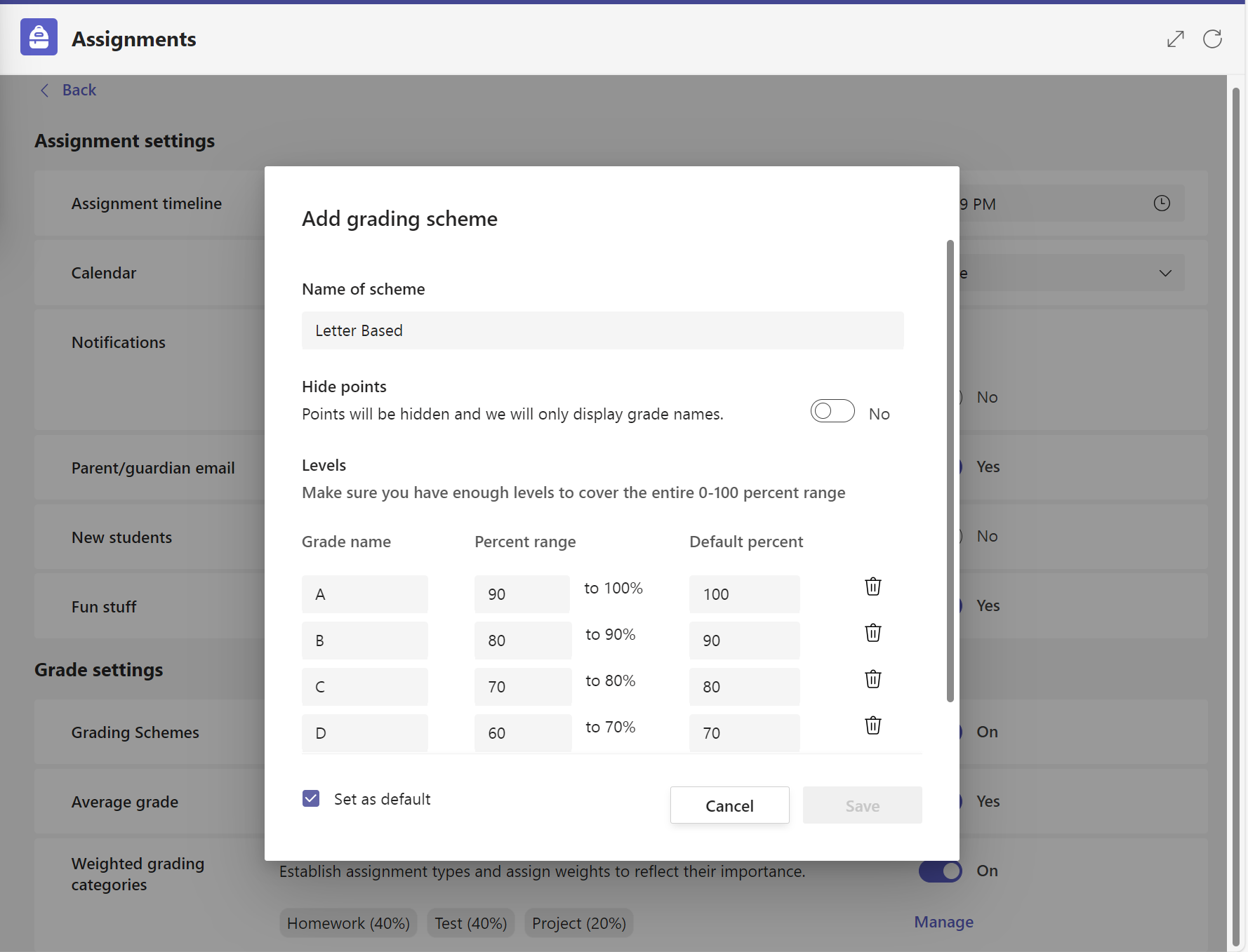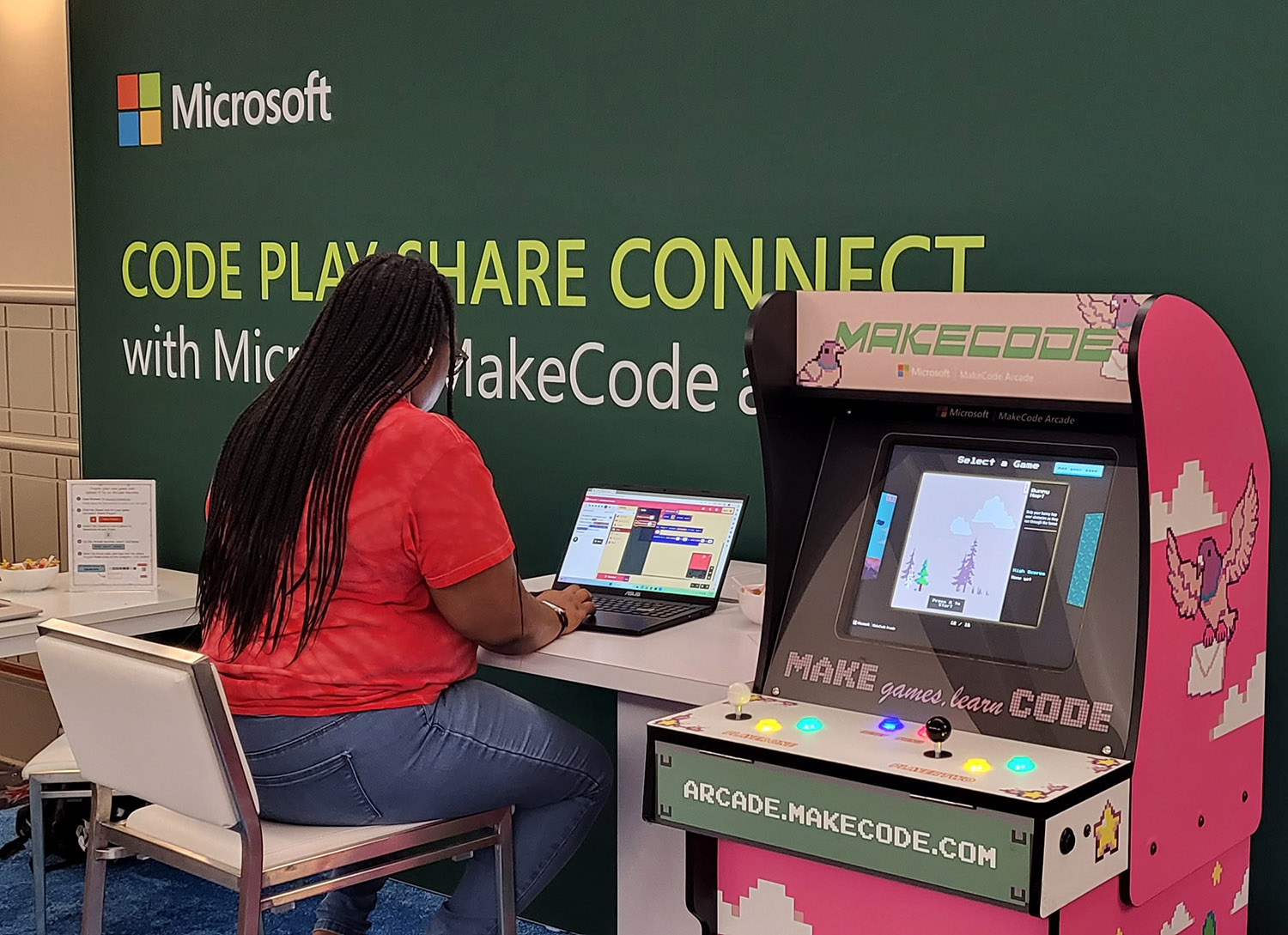ISTELive 23 ends today, and as always, it was an energizing four days of connecting, learning, and sharing.
This year we announced lots of exciting new developments and updates, and presented sessions on the Spotlight on Solutions stage, in our Microsoft Learn Live Classroom, at the Microsoft Learn Theater in our booth. We also let hundreds of eager educators get their hands on the latest Learning Accelerators, Minecraft worlds, and more throughout our exhibit.
What everyone’s talking about: AI
As you might have guessed, AI stole the show. It’s definitely one of the main topics on many educators’ minds, and new technologies and tools are being developed regularly.

A session from Microsoft Education at ISTELive 23.
During ISTELive 23, we shared several announcements about new collaborations bringing AI innovation to education, as well as updates to our AI-powered Learning Accelerators. We also shared information about new training opportunities to help more people gain the skills to make positive use of the technology. Some of the highlights included:
New AI course for educators: “Empower educators to explore the potential of artificial intelligence” available on Microsoft Learn – approximately 200 people attended live sessions and completed the course at ISTELive 23.
AI Skills initiative: We’re excited to share news about a new AI Skills initiative to help people and communities around the world learn how to harness the power of AI. The Microsoft AI Skills initiative includes new, free coursework developed with LinkedIn; a new open global challenge in coordination with data.org to uncover new ways of training workers on generative AI; and greater access to free digital learning events and resources for everyone to improve their AI fluency.
Collaboration between Microsoft and New York City Schools: We were extremely proud to share that we have been working with New York City Public Schools to support their exploration of the development of generative AI tools tailored for their own use and to help ensure they can lead the way in the responsible, safe, and innovative use of AI by implementing appropriate safety and security measures.
New collaborations with PowerSchool and Kahoot!: We’ve also been working with PowerSchool and Kahoot! to enable their new AI-powered experiences with the Azure OpenAI Service.
- PowerSchool recently shared their vision to deliver personalized learning pathways built for individual students based on their learning goals within a secure platform. This new collaboration between PowerSchool and Microsoft provides additional functionality within the PowerSchool Personalized Learning Cloud that lets educators save time by leveraging AI to create formative assessments aligned to a desired learning objective, grade level, subject, and standard.
- Kahoot! began weaving generative AI into their product suite as an extension of their long-lasting commitment to innovation and making learning efficient, accessible, and engaging. While Kahoot! has already been on an AI journey, new capabilities offered by the Azure OpenAI Service have enabled them to further enhance their experience and save time for educators.
AI-powered Reading Progress updates: We announced several new features coming to Reading Progress: Reading with expression, passage generation, and comprehension question generation.
- Reading with expression: With our forthcoming Expression update, Reading Progress will automatically identify students’ performance on aspects of prosody including monotone reading, long pauses, and not pausing for a period, comma, or exclamation points. Student expression results will be available in the teacher review experience, alongside accuracy and correct words per minute. Later, this information will be added to the student’s view of their returned work and incorporated in Education Insights so it can be easily monitored over time. Reading expression updates will begin rolling out in July.

An educator’s view of the Expression tab in Reading Progress in Microsoft Teams for Education.
- Passage generation: Another new feature in the works is passage generation, which will allow educators to generate a passage directly in Reading Progress, and also leverage insights to customize it based on the needs of their class and individual students. Passage generation is in an initial private preview with our testing community.
- Comprehension questions: To assist educators in evaluating reading fluency, Reading Progress will soon include a new feature that can generate comprehension questions based on a specific reading passage. Educators can choose the number of questions and then review them, make any necessary edits, and publish to students. Comprehension questions is also in an initial private preview with our testing community.
Visit our recent blog post “Collaborating to bring AI innovation to education” to learn more details about these announcement and updates.
More collaborations, updates, and new tools for educators!
The AI-related announcements were just a few of the exciting developments we’ve been working on that we shared at ISTELive 23. We also debuted news about our powerful alliance with CDW, a host of additional updates in Microsoft Teams, and the first ever Viva Connections for education.
CDW is customizing their existing Microsoft services to provide education-specific consultation, support, and training so schools are aware of everything they have access to, and feel confident in implementing what they already have in their Microsoft licensing structure.
- As part of the CDW Amplified for Education effort, the CDW Education Collaborative (formerly the North American Google Technical Collaborative) has been expanded so that schools can learn how to successfully implement and manage Microsoft technologies side-by-side with their peers, as well as CDW and Microsoft experts.
- The CDW Education Collaborative is a community of K–12 IT professionals based in the United States and Canada, providing a virtual meeting place where IT leaders can solve problems and network. The Collaborative now serves more than 1,250 school districts across North America to connect and support school districts, and it has greatly expanded its scope to address those schools and districts using Microsoft’s software and solutions.
Teams for Education improvements for educators: There are several updates coming to Teams that are designed to save time, and help teachers organize their assignments and resources.
- Classwork: The Classwork app is a one-stop solution to create and organize class content and help manage your curriculum in Teams. Classwork will allow educators to create and organize class resources including Assignments, Files, Links, Channels, Class Notebook pages, and more. In Classwork, educators can organize resources into modules aligned with their curriculum structure so that students can more easily navigate the class and find relevant resources. This new feature will be rolling out starting next week.
- Assignment workflow updates — actionable Ready to Grade list view: Want a one click place to see all assignments that have submissions that you can act on? We’ve added a new tab to the list view called Ready to Grade. This list will only show assignments (past or upcoming) where students have submitted work that has not yet been graded. We’ve also updated the Past Due list to only show assignments that are past their due dates and still have one or more students that have not yet submitted their work. Additionally, we’ve updated the Assignments Card to provide more information at a glance, such as the number of submissions that are ready to grade or the number of submissions that are past due. These updates are available now.

The Ready to grade and Past due tabs in Assignments in Microsoft Teams for Education.
- Alternative grading scheme: We are working on a new feature for Assignments and Grades that allows educators to use different grading schemes for grading inside Teams. Today in Assignments we support the ability to use points (and rubrics) for your grades, but some schools don’t use points or use different grading systems. We are now adding the ability for you to add mappings to different customizable schemes that are all customizable for each class, as well as added support for multiple schemes per class. These features are expected to start becoming available around August 2023.

Adding a new grading scheme in Assignments in Microsoft Teams for Education.
- Viva Connections for Education: Microsoft Viva Connections for Education is a digital home that centralizes all the resources students need in one place, directly within Microsoft Teams. With intuitive design and easy access, the dashboard is personalized for each student’s individual needs, giving them a digital home where they can start and end each day—helping them stay connected to their educational institution at every step along their academic journey. Microsoft is happy to announce that Viva Connections for Education is now available to all customers as part of our Teams for Education offering. Read more in the Viva Connections blog.
Most talked-about sessions
It’s impossible to pick a favorite from the many informative and engaging sessions that the team presented, but a few highlights were:
- In our standing-room-only Spotlight on Solutions session: “Unlocking AI’s potential: Transform learning experiences and prepare for the future,” representatives from NYC Public Schools, Kahoot!, PowerSchool, and Microsoft shared some of the exciting details of projects and collaborations that are tapping into the immense potential of AI to empower K-12 teachers to create transformative and engaging learning experiences.
- Another Spotlight on Solutions event that caused a lot of buzz was: “The future of learning with Microsoft Flip”. In this session, experts shared how Microsoft Flip leverages AI capabilities such as Topic Copilot, Reading Coach, and recent innovations to help teachers and students create engaging and meaningful learning experiences.
- In the Microsoft Learn Live Classroom: “Discover Learning Accelerators: Search Coach and Search Progress” was a huge hands-on hit. Demonstrations showed attendees how to make the most of these new Learning Accelerators, and shared strategies to build information literacy into learning in engaging ways.
- “Back-to-safe: Starting the year with Minecraft’s new cyberskilling K12 Lessons” demonstrated how Minecraft worlds, including new “Privacy Prodigy” can help impart critical digital citizenship and cybersecurity skills, including managing screen time, social interactions, online spending, and recognizing malware. The presenters even shared information about how the cybersafe collection can be integrated into back-to-school motions and family support of digital learning.
Code & Connect with Microsoft MakeCode and Flip
Outside the Microsoft Learn Live Classroom sessions, attendees had the opportunity to get hands-on with game-based learning and computational thinking with Microsoft MakeCode Arcade. Educators experienced how easy it was to code their own video game within 5 minutes, and then upload the game they created to a retro Arcade machine so they and others could play their games using a joystick and buttons. Educators also had the opportunity to reflect on their experiences by recording a video on Microsoft Flip and entering the ISTE Fliphunt for a chance to win a Surface device. Many educators walked away from the experience with a new appreciation for how easy it is to incorporate inclusive, engaging computational skills, game-based and social learning into their classrooms.

An educator coding a video game with Microsoft MakeCode at ISTELive 23.
ISTE Learn Challenge
The ISTE Learn Challenge is a collection of modules and key learnings based on the content from ISTELive 23. Whether you were at ISTELive 23 or not, grow your technology toolbox and sharpen your skills with this curated collection of free asynchronous learning modules. Explore how you can support all learners in your classroom.
Looking toward next year!
All of the updates, developments, and announcements we shared this year made ISTELive 23 feel especially exciting. It’s hard to imagine what incredible advancements we might be talking about next year! For now, it’s time to take the summer to absorb the impact of these innovations, listen to feedback, and work to make them even more valuable tools to empower educators and engage students. We hope the summer is a great time for you to relax a bit, catch up with all the incredible new learning opportunities like the new AI course built for educators, and some of the sessions in the ISTE Learn Challenge. Thanks for making this an incredible ISTELive, enjoy your summer!







